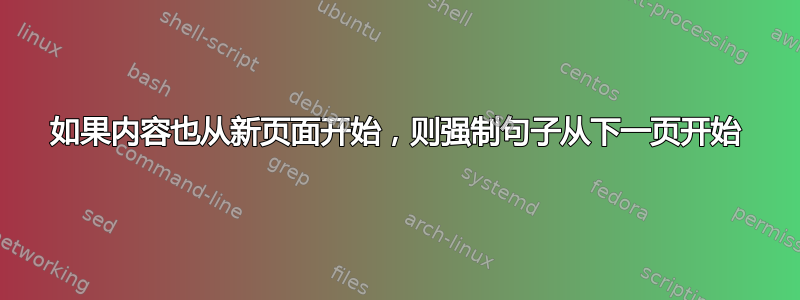
对于我的家庭作业,我使用这个环境:
\newcounter{exercise}
\renewcommand{\theexercise}{\arabic{exercise}}
\newenvironment{exercise}[1]
{\smallskip\refstepcounter{exercise}\textbf{Solution to exercise~\theexercise:}\par\vspace{#1}}
{\par \hspace*{\fill}$\square$\medskip}
有时,我会发现“练习 x 的解决方案”位于页面末尾,而解决方案从下一页开始,或者末尾的“$square$”从下一页开始。我想知道是否有可能让 tex 检查下一行是否从下一页开始,然后强制它将“练习 x 的解决方案”也放到下一页,或者在另一种情况下,它会检查“$square$”是否从下一页开始,并将之前的一行也放到下一页。
仍然会导致问题的代码:
\begin{center}
\begin{tikzpicture}[point/.style={fill, circle, inner sep = 1.3pt}]
%x axis
\draw[->] (-2,0) -- (6,0) node[below] {$x$};
\foreach \x in {-1,1,2,...,5}
\draw[shift={(\x,0)}] (0pt,2pt) -- (0pt,-2pt) node[below] {\footnotesize $\x$};
%y axis
\draw[->] (0,-2) -- (0,3) node[left] {$y$};
\foreach \y in {-1,1,2}
\draw[shift={(0,\y)}] (2pt,0pt) -- (-2pt,0pt) node[left] {\footnotesize $\y$};
\node[below left] at (0,0) {\footnotesize $0$};
% points
\node (H) [point,label=above:$H$] at (1,1) {};
\node (F) [point,label=above:$F$] at (4,2) {};
\node (X) [point,label={[label distance=0.15cm]350:$x^*$}] at (2,0) {};
% river
\draw[blue, line width = 0.4mm] (-1.5,0) -- (5.5,0);
% path
\draw[dashed] (H) -- (X);
\draw[dashed] (X) -- (F);
\end{tikzpicture}
\end{center}
答案1
正如@user202729在评论中指出的那样,您可以在代码中\nopagebreak直接在宏之后使用。如果您将参数添加到此宏中,则 (La)TeX 此时破坏页面的可能性很小。\par[4]
如果您还想防止出现寡妇(即下一页上的一行),您可以\widowpenalty10000在代码开头进行额外设置。
下面的代码包含两个极端的例子,表明在页眉和正文之间以及正文和方块之间将防止分页:
\documentclass{article}
\usepackage{amssymb}
\usepackage{lipsum, xcolor} % just for illustrative purposes
\newcounter{exercise}
\renewcommand{\theexercise}{\arabic{exercise}}
\newenvironment{exercise}[1]
{\widowpenalty10000\smallskip\refstepcounter{exercise}\textbf{Solution to exercise~\theexercise:}\par\nopagebreak[4]\vspace{#1}}
{\par\nopagebreak[4]\hspace*{\fill}$\square$\medskip}
\begin{document}
{\color{lightgray}\lipsum[1-3]}
\begin{exercise}{1.6cm}
\lipsum[1]
\end{exercise}
{\color{lightgray}\lipsum[1-3]}
\begin{exercise}{5cm}
\lipsum[1]
\end{exercise}
\end{document}
答案2
我建议amsthm在校样结束时使用其内置的方块机制。
\documentclass{article}
\usepackage{amsthm}
\usepackage{tikz}
\usepackage{showframe,lipsum} % just for this example
\theoremstyle{definition}
\newtheorem{innerexercise}{Solution to exercise}
\newenvironment{exercise}
{\pushQED{\qed}\innerexercise}
{\popQED\endinnerexercise}
\begin{document}
\begin{exercise}
\lipsum[1][1-4]
\[
\begin{tikzpicture}[point/.style={fill, circle, inner sep = 1.3pt}]
%x axis
\draw[->] (-2,0) -- (6,0) node[below] {$x$};
\foreach \x in {-1,1,2,...,5}{
\draw[shift={(\x,0)}] (0pt,2pt) -- (0pt,-2pt) node[below] {\footnotesize $\x$};
}
%y axis
\draw[->] (0,-2) -- (0,3) node[left] {$y$};
\foreach \y in {-1,1,2}{
\draw[shift={(0,\y)}] (2pt,0pt) -- (-2pt,0pt) node[left] {\footnotesize $\y$};
}
\node[below left] at (0,0) {\footnotesize $0$};
% points
\node (H) [point,label=above:$H$] at (1,1) {};
\node (F) [point,label=above:$F$] at (4,2) {};
\node (X) [point,label={[label distance=0.15cm]350:$x^*$}] at (2,0) {};
% river
\draw[blue, line width = 0.4mm] (-1.5,0) -- (5.5,0);
% path
\draw[dashed] (H) -- (X);
\draw[dashed] (X) -- (F);
\end{tikzpicture}\qedhere
\]
\end{exercise}
\begin{exercise}
\lipsum[2][1-9]
\end{exercise}
\end{document}
通过数学显示,您可以确保图片之前不会出现分页符。
如果您希望文本从新行开始:
\documentclass{article}
\usepackage{amsthm}
\usepackage{tikz}
\usepackage{showframe,lipsum} % just for this example
\newtheoremstyle{exercise}
{\topsep} % ABOVESPACE
{\topsep} % BELOWSPACE
{\normalfont} % BODYFONT
{0pt} % INDENT (empty value is the same as 0pt)
{\bfseries} % HEADFONT
{:} % HEADPUNCT
{\newline} % HEADSPACE
{} % CUSTOM-HEAD-SPEC
\theoremstyle{exercise}
\newtheorem{innerexercise}{Solution to exercise}
\newenvironment{exercise}
{\pushQED{\qed}\innerexercise}
{\popQED\endinnerexercise}
\begin{document}
\begin{exercise}
\lipsum[1][1-4]
\[
\begin{tikzpicture}[point/.style={fill, circle, inner sep = 1.3pt}]
%x axis
\draw[->] (-2,0) -- (6,0) node[below] {$x$};
\foreach \x in {-1,1,2,...,5}{
\draw[shift={(\x,0)}] (0pt,2pt) -- (0pt,-2pt) node[below] {\footnotesize $\x$};
}
%y axis
\draw[->] (0,-2) -- (0,3) node[left] {$y$};
\foreach \y in {-1,1,2}{
\draw[shift={(0,\y)}] (2pt,0pt) -- (-2pt,0pt) node[left] {\footnotesize $\y$};
}
\node[below left] at (0,0) {\footnotesize $0$};
% points
\node (H) [point,label=above:$H$] at (1,1) {};
\node (F) [point,label=above:$F$] at (4,2) {};
\node (X) [point,label={[label distance=0.15cm]350:$x^*$}] at (2,0) {};
% river
\draw[blue, line width = 0.4mm] (-1.5,0) -- (5.5,0);
% path
\draw[dashed] (H) -- (X);
\draw[dashed] (X) -- (F);
\end{tikzpicture}\qedhere
\]
\end{exercise}
\begin{exercise}
\lipsum[2][1-9]
\end{exercise}
\end{document}







